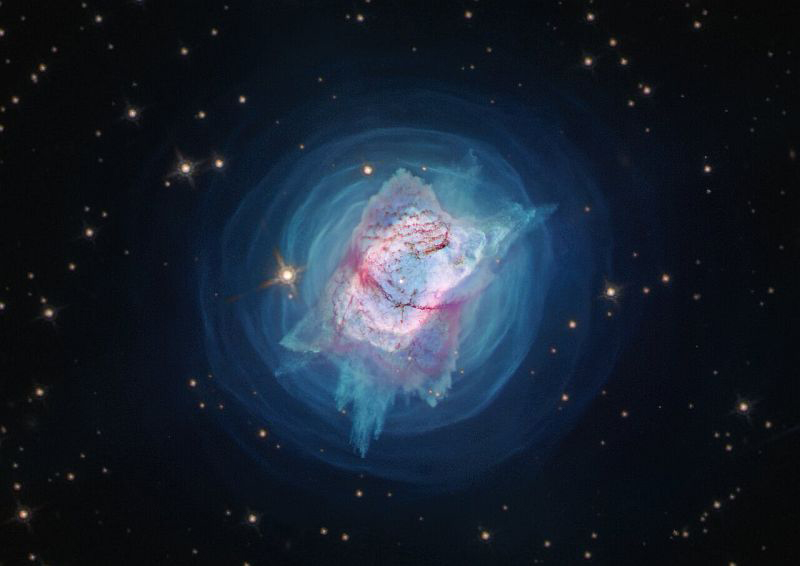Hubble’s Jewel Bug
by Harley White
- Published: Friday, July 03 2020 20:46

Seldom are insects my poetry themes
though butterflies have been versified twice,
but the jewel bug is a type that gleams
with hues iridescent to eyes entice.
These Scutelleridae have backs with ‘shields’
and coloration resembling a gem,
albeit defenses this ‘jewel’ wields
are ‘stink bug’ related in smell, ahem.
A new Hubble image of NGC
seven oh two seven shows how the name
the Jewel Bug seems to fit vis-à-vis
the nebula’s complex structural frame.
When viewed with its Wide Field Camera Three
so picture spanned much of visual range
from near-ultraviolet to degree
of near-infrared light, such vivid change
induced one astronomer to declare
that he was ‘floored’ by the details he saw
of spherical shapes in cloverleaf rare
from dramatic ejections, causing awe.
This ‘nebula planetary’ was first
by Hubble seen in nineteen ninety-eight.
The clearer display of layers dispersed
helps scientists grasp its evolving fate.
(While not ‘planetary’, the term has stuck
to these astral objects dubbed in the past.)
With ‘Jewel’ something must have run amuck
in the center, they think, to sculpt that cast.
Binary stars could be playing a part
closely revolving, meanwhile in stages
shedding sidereal stuff from the heart
at the beginning, for many ages,
followed by much more potent expulsions,
each stream spurting out as directed jet,
and when the new would meet old convulsions
the form of the nebula they’d beget.
In Cygnus, Swan, constellation it lies
‘tis said, about three thousand light-years far
from this earth we tread so near to our eyes
circumnavigating round sunny star.
Here on our planet, jewel bugs can be
mistaken for beetles, yet ‘true bugs’ they’re
called, since beetles chomp in an eating spree,
while jewel bugs feed with a sucking flair.
‘A beetle that’s trod upon suffers pain’,
wrote Shakespeare that Bard uncommonly wise,
‘corporeal’, apropos its domain
‘as great’ in extreme ‘as when giant dies’.
I grant there are insects thought of as pests,
some of them even a cause for alarm
to varied beings, as science attests,
plus others which lead to bodily harm.
But the bee, for instance, is essential
to pollinate plants of foods we consume,
a perception that’s proved providential,
for bees’ extinction could bring on our doom.
Yet with lack of awareness prevailing
balanced against technological knack
and our greed a predominant failing,
it would seem Man has gotten off the track.
Disorders of senses our vision cloud
as humans indulge in hubristic quirk,
deaf to cries of dismay, however loud,
much like artful animals gone berserk.
Dostoyevsky in ‘Karamazov’ penned
about so-called ‘bestial cruelty’ claimed
that no ‘beast’, or animal, would descend
to levels of mankind’s cruelty famed.
Such words, to rephrase, ‘insult those creatures
and do to their species injustice great’,
for ‘beasts’ don’t display Man’s brutal features.
Thus it is ourselves that we should berate.
Oft I despair at the havoc we wreak
on this sapphire sphere so seemingly rare
while appearing to forge a future bleak
with barely a backward glance or beware.
Might that Jewel Bug by Hubble beheld
mirror an aspect of earth’s lovely face,
reminding of wonders unparalleled,
like a vast looking glass in outer space
illuminating our home heaven-sent
and the precious world we mortals were lent,
as a wake-up call of cosmic extent,
lest we’re left with naught but a last lament?
~ Harley White
* * * * * * * *
Some sources of inspiration were the following…
Scutelleridae (sku-tel-er'-i-de) ~ Wikipedia…
https://en.wikipedia.org/wiki/Scutelleridae
“People talk sometimes of a bestial cruelty, but that’s a great injustice and insult to the beasts; a beast can never be so cruel as a man, so artistically cruel…”
~ Fyodor Dostoyevsky (1821-1881, ‘The Brothers Karamazov’…
“And the poor beetle, that we tread upon,/ In corporal sufferance finds a pang as great/ As when a giant dies.”
~William Shakespeare (1564-1616), ‘Measure for Measure’…
NGC 7027 ~ Wikipedia…
https://en.wikipedia.org/wiki/NGC_7027
NGC 7027…
https://www.spacetelescope.org/images/heic2011c/
Image explanation ~ This image from the NASA/ESA Hubble Space Telescope depicts NGC 7027, or the “Jewel Bug” nebula. The object had been slowly puffing away its mass in quiet, spherically symmetric or perhaps spiral patterns for centuries — until relatively recently when it produced a new cloverleaf pattern. New observations of the object have found unprecedented levels of complexity and rapid changes in the jets and gas bubbles blasting off of the star at the center of the nebula.
Credit: NASA, ESA, and J. Kastner (RIT)







Comments